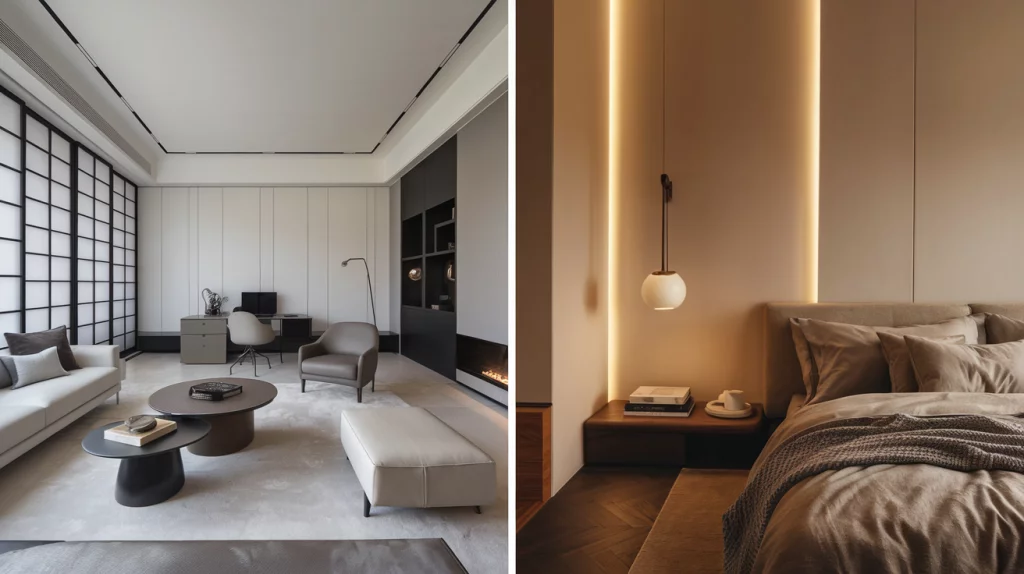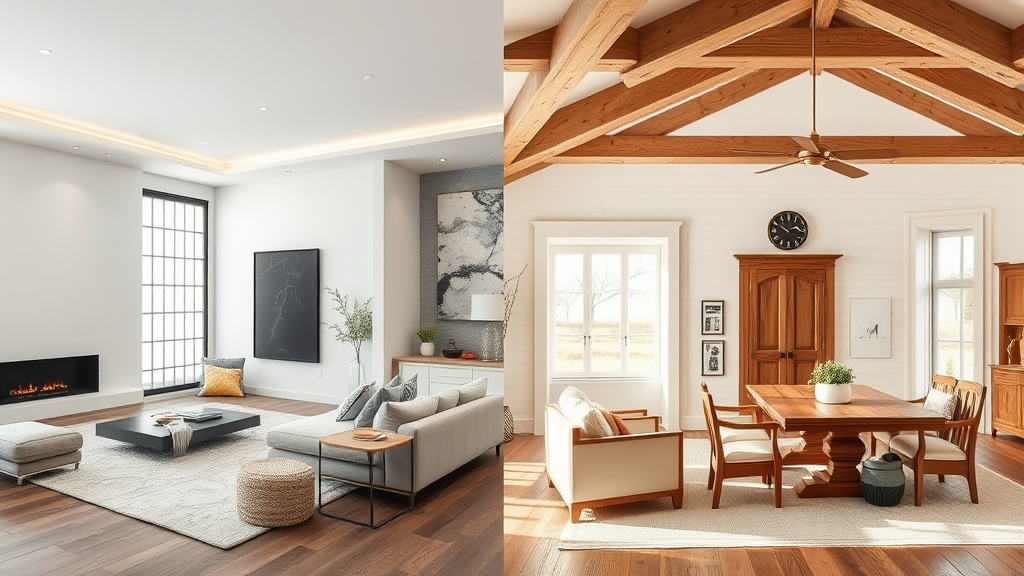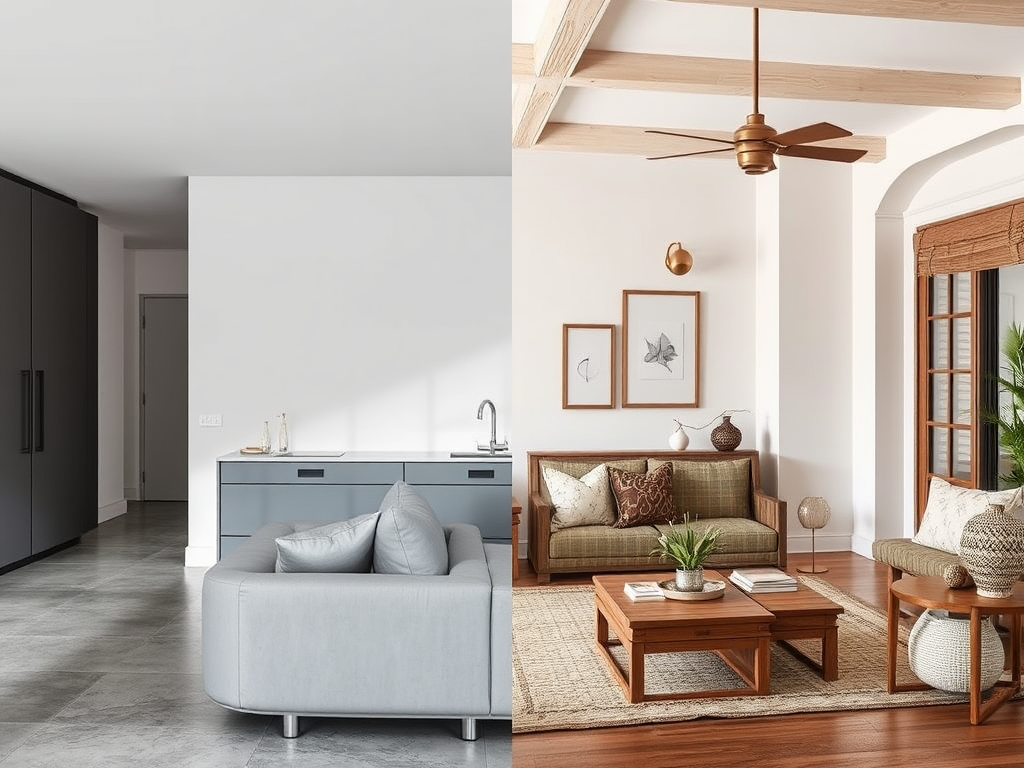What’s with all the white paint choices making decisions so hard?
Picking the right white paint feels like solving a puzzle – staring at dozens of seemingly identical swatches, second-guessing every choice.
I’ve been there, too, watching clients pull their hair out, trying to tell the difference between Shoji White and Alabaster.
But here’s something most people don’t know: These two popular whites have distinct personalities that can make or break a room’s atmosphere.
I’ll show you the key details that set them apart so you can confidently make your choice.
After reading this guide, you’ll know exactly which white paint will give your space the perfect look you want.
Quick Comparison: Shoji White vs. Alabaster
Looking at these two Sherwin-Williams colors side by side reveals some important differences that make each unique. Let me share what the testing shows.
| Feature | Shoji White | Alabaster |
|---|---|---|
| Undertones | Soft warm gray-beige (greige) undertones | Creamy white with subtle warm undertones |
| Light Reflectance Value | Approx. 74 (moderate brightness) | Approx. 82 (higher brightness) |
| Best Lighting | Works well in spaces with natural or bright artificial light | Performs well in low-light or dim areas |
| Style Suitability | Modern, minimalist, and transitional designs | Traditional, farmhouse, or cozy styles |
| Ideal Room Types | Living rooms, kitchens, and offices | Bedrooms, bathrooms, and reading nooks |
| Complementary Colors | Cool grays, whites, blacks, and metallics | Beiges, browns, and natural wood tones |
| Vibe | Subtle, sophisticated, and neutral | Warm, inviting, and creamy |
Shoji White: Understanding Its Unique Appeal
Detailed Characteristics
Understanding the Color: Shoji White sits in a unique spot between white and beige in the Sherwin-Williams lineup. It brings subtle, warm undertones with hints of beige and gray working together.
Light Interaction: Natural light reveals different aspects of this versatile color throughout the day. Shoji White feels warm and inviting in your south-facing rooms, while north-facing spaces showcase its ability to soften cool light without turning dull.
Best Applications
Modern Spaces: In contemporary homes, Shoji White creates an ideal backdrop without the starkness of pure white. It particularly shines in minimalist settings where its subtle depth adds interest without compromising the clean aesthetic modern spaces demand.
Versatile Pairings: When it comes to decor, Shoji White plays well with others. It creates beautiful combinations with both warm and cool grays, natural wood tones, and various metal finishes.
Examples in Real Homes
Kitchen Transformation: One homeowner used Shoji White to transform their dark kitchen into a bright, welcoming space. The color provided enough contrast against white countertops while maintaining harmony with natural wood elements.
Living Space Success: In an open-concept living area, Shoji White created a seamless flow between spaces while offering enough visual interest to prevent the large area from feeling bland.
Bedroom Application: A north-facing bedroom showcased Shoji White’s ability to brighten without feeling cold. The color created a restful atmosphere while providing a perfect backdrop for both light and dark furniture pieces.
Alabaster: A Closer Look at Its Features
Detailed Characteristics
Color Properties and Undertones: Alabaster is a warm, inviting white with a high LRV of 82. This puts it firmly in the true white category, though it has subtle yellow undertones that give it a distinctive personality.
Light Response and Brightness: Alabaster’s high light reflectance makes it a powerful brightening tool in smaller spaces or rooms with limited natural light.
Best Applications
Interior Spaces: In north and east-facing rooms, Alabaster shows its true strength by warming up naturally cool light. The color creates an especially welcoming atmosphere in living rooms and bedrooms where soft, comfortable lighting is desired.
Design Pairings: Natural wood elements are the perfect partner for Alabaster. The color’s creamy undertones complement both light and dark wood tones, creating balanced, harmonious spaces.
Examples in Real Homes
Living Areas: Several homeowners have transformed their living spaces using Alabaster on walls with Pure White trim. This combination creates subtle depth while maintaining brightness.
Light Management: A particularly striking transformation occurred in a north-facing room where Alabaster replaced a cooler white. The space immediately felt warmer and more inviting while still maintaining its brightness.
Style Versatility: In a recent farmhouse renovation, Alabaster proved its versatility by working beautifully across different rooms with varying light conditions.
Side-by-Side Comparison to Match Your Intent
1. Room Type

Shoji White (LRV 74)
- Best for living rooms, kitchens, and home offices.
- Sophisticated and consistent backdrop for active spaces.
- Creates contrast in kitchens and a focused ambiance in offices.
Alabaster (LRV 82)
- Ideal for bedrooms, bathrooms, and reading nooks.
- A soft, warm glow promotes relaxation.
- Brightens small spaces, especially in cooler, north-facing rooms.
2. Style Goals

Shoji White
- Complements modern and minimalist designs.
- Adds depth and sophistication to contemporary spaces.
- Maintains clean, sleek lines under changing light conditions.
Alabaster
- Perfect for traditional and farmhouse-inspired styles.
- Warm and timeless, yet fresh for current design trends.
- Creates an inviting and graceful atmosphere.
3. Décor Compatibility

Shoji White Matches
- Cool grays and sleek furniture
- Matte black hardware
- Modern metallic finishes
- Concrete or stone surfaces
Alabaster Matches
- Warm wood tones
- Natural fiber textiles
- Antique brass fixtures
- Organic, textured elements
How to Make the Final Decision
Factors to Consider
Lighting Assessment: Your room’s natural light will significantly impact how these colors appear. Shoji White (LRV 74) shows its subtle depth in varying light conditions, while Alabaster (LRV 82) brightens spaces with its higher reflectance. Watch how morning and afternoon light affects each color in your space.
Room Dimensions: Consider your space size when choosing. Alabaster can make smaller rooms feel more open, while Shoji White adds depth to larger spaces without feeling stark. Your ceiling height also matters – both colors perform differently in rooms with varying heights.
Design Preference: Your style guides this choice. Shoji White suits modern, clean aesthetics, while Alabaster enhances traditional and cozy spaces. Think about which matches your existing décor and the atmosphere you want to create.
Testing Tips
The first step to finding your perfect white is preparing your paint sample boards. Paint at least two large boards—one with Shoji White and one with Alabaster.
Move these boards around your space throughout the day to see how they react to changing light.
Morning sun tells one story, while evening light might reveal something completely different.
Don’t forget to place your samples near the elements that will live permanently in your room.
Hold them next to your couch, place them against your hardwood floors, and see how they look near your curtains.
Even small things like picture frames and throw pillows can affect how these whites appear in your space.
Make this testing phase your friend – there’s no rush. Spend a few days with your samples before making your final choice.
The time you invest in testing now will reward you with a color you’ll love for years to come.
Expert Recommendations
Making a Choice
Interior designers frequently cite light conditions as the key deciding factor between these whites.
In the north—and east-facing rooms, Alabaster’s warmth (LRV 82) helps balance cooler natural light.
Shoji White’s more subtle presence (LRV 74) helps manage strong sunlight without washing out for south- and west-facing spaces.
Common Pitfalls
Many homeowners make simple mistakes when selecting whites that affect their results. Testing colors only in one lighting condition often leads to disappointment.
Another frequent error is not considering existing white elements like trim or cabinets—these comparisons matter significantly in the final look.
Design Insights
Professional designers suggest:
- Sample your chosen white next to fixed elements like countertops and tile
- Consider your flooring’s undertones
- Think about how the color will flow from room to room
- Test samples on multiple walls, as corner shadows can change color appearance
Remember that finding your perfect white might take time. Rushing this decision rarely leads to satisfying results. Both Shoji White and Alabaster offer beautiful options when used in the right setting.
Conclusion
Choosing between Shoji White and Alabaster comes down to understanding your space and needs.
Both colors offer unique qualities. Shoji White, with its LRV of 74, brings subtle depth and modern appeal, while Alabaster beautifully brightens spaces with its LRV of 82.
Depending on your lighting conditions, room size, and personal style preferences, one color will be the better choice.
Remember, these whites aren’t just paint colors; they’re tools for creating the atmosphere you want in your home.
Your perfect white awaits, informed by your space’s unique characteristics.

